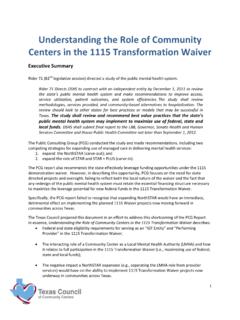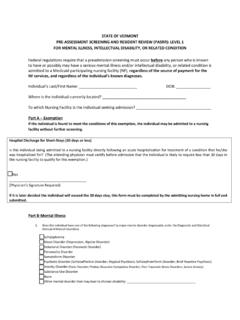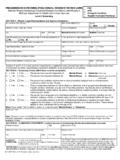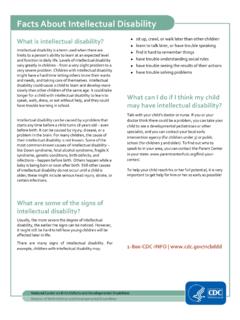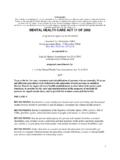Transcription of DSM-5 Changes in Intellectual Disabilities and …
1 DSM-5 Changes in Intellectual Disabilities and mental health Disorders Maria Quintero, , FAAIDD MHMRA of Harris County June 2013 Disclosure to Participants Requirements for Successful Completion of Continuing Education Activity Requires: the registration form, the Sign in Sheet the entire educational activity in education activities the participant evaluation Commercial Support: This educational activity received no commercial support. Disclosure of Conflict of Interest The speakers and planning committee have disclosed no conflict of interest. Non-Endorsement Statement Accredited status does not imply endorsement by the DSHS, Continuing Education Service, Texas Medical Association or American Nurse Credentialing Center of any commercial products or services. Off-Label Use The speakers did not disclose the use of products for a purpose other than what it had been approved for by the Food and Drug Administration.
2 Expiration Date for Awarding Contact Hours Complete the attendance sheet and evaluation by the end of session. MESSENGER Objectives By the end of this presentation, participants will be able to: Explain the process of diagnosing mental illnesses and developmental Disabilities without the traditional five-axis format List at least three Changes in specific diagnostic categories listed in the DSM-5 change in name and criteria for Intellectual disability, including shift away from primary reliance on IQ scores Impact of change in criteria for autism spectrum disorder upon patients who may no longer meet diagnostic criteria Changes in criteria of major mental illnesses treated in public MH system in Texas: schizophrenia, bipolar disorder and major depression Discuss implications for impact in healthcare, educational and other systems The Diagnostic and Statistical Manual of mental Disorders DSM American Psychiatric Association s Diagnostic and Statistical Manual of mental Disorders The manual that guides the diagnostic process.
3 The origins of the DSM date back to 1840 when the government wanted to collect data on mental illness. The term idiocy/insanity appeared in that year s census. Forty years later, the census expanded to feature these seven categories: mania, melancholia, monomania, paresis, dementia, dipsomania and epilepsy. In 1917, the Bureau of the Census embraced a publication called the Statistical Manual for the Use of Institutions for the Insane. It was created by the Committee on Statistics of the American Medico-Psychological Association (now the American Psychiatric Association) and the National Commission on mental Hygiene. The committees separated mental illness into 22 groups. The manual went through 10 editions until 1942. American Psychiatric Association s Diagnostic and Statistical Manual of mental Disorders 1952 DSM-I featured descriptions of 106 disorders, which were referred to as reactions. Disorders also were split into two groups based on causality 1968 The DSM-II came out.
4 It was only slightly different from the first edition. It increased the number of disorders to 182 and eliminated the term reactions because it implied causality and referred to psychoanalysis 1980 The DSM III was published with a major shift from its earlier editions. DSM-III dropped the psychodynamic perspective in favor of empiricism and expanded to 494 pages with 265 diagnostic categories. Leaned more toward German psychiatrist Emil Kraepelin s position that biology and genetics played a key role in mental disorders. American Psychiatric Association s Diagnostic and Statistical Manual of mental Disorders 1994 There was another increase in the number of disorders (over 300), and this time, the committee was more conservative in their approval process. In order for disorders to be included, they had to have more empirical research to substantiate the diagnosis. 2000 DSM-IV was revised once, DSM IV TR, but the disorders remained unchanged.
5 Only the background information, such as prevalence and familial patterns, was updated to reflect current research. The DSM-5 was released in mid-May 2013 A number of significant Changes Attempt to make the new diagnostic symptom be compatible with ICD-10 and ICD-11 (expected in 2015) Future revisions will be made online Overview of Changes in the DSM-5 Developmental focus Depends on thorough assessment of developmental characteristics of disorders Discontinuation of five-axis diagnostic profile Category: Neurodevelopmental Disorders, now Autism Spectrum Disorders Intellectual Disability Changes Schizophrenia and Schizoaffective Disorder Bipolar Disorder Depressive Disorders Additional Changes in many other disorders A New Approach Case Formulation A synthesis of the assessments and observations in a case, which organizes and integrates relevant information around identified core factors around which the person s difficulties revolve.
6 The case formulation drives treatment planning and therapy. This is a thoughtful approach, not achieved through checklist or time-limited evaluations The process requires clinical training to identify symptomatic excesses and deficits. The Diagnosis Diagnoses should have utility Help determine prognosis, treatment plans and potential treatment outcomes Having a diagnosis = Need for treatment Diagnostic criteria are guidelines, not strict criteria Heavy emphasis on clinical judgment Anatomy of a Diagnosis Diagnostic Criteria? Are the symptoms described by a disorder? Anatomy of a Diagnosis Diagnostic Criteria? Are the symptoms described by a disorder? Subtype? Mutually exclusive subgroupings under a diagnosis Specify Anatomy of a Diagnosis Diagnostic Criteria? Are the symptoms described by a disorder? Subtype? Mutually exclusive subgroupings under a diagnosis Specify Specifiers? One person may have several Information relevant to treatment Course Descriptive features Specify Anatomy of a Diagnosis Diagnostic Criteria?
7 Are the symptoms described by a disorder? Subtype? Mutually exclusive subgroupings under a diagnosis Specify Specifiers? One person may have several Information relevant to treatment Course Descriptive features Specify Severity? Loosely connected to level of need for support Specify current No More Axes DSM-IV Axis I Clinical Disorders Pervasive Developmental Disorders Axis II Developmental Conditions Personality Disorders Axis III General medical conditions Axis IV Psychosocial and Environmental Problems Axis V Global Assessment of Functioning DSM-5 Axes I, II & III are combined Axis IV discontinued ICD 10-CM Z codes are being examined as possible alternative for capturing psychosocial and environmental factors Axis V discontinued Lack of content clarity Lack of psychometric integrity Will explore possible use of World health Organizations Disability Assessment Schedule (WHODAS) Neurodevelopmental Disorders From PDD to ASD DSM IV TR Pervasive Developmental Disorder Autistic Disorder Asperger s Disorder Pervasive developmental Disorder, NOS Childhood Disintegrative Disorder Rett s Disorder DSM-5 Autism Spectrum Disorder (ASD) Rationale The distinctions among the disorders have been inconsistent and often based on variables other than criteria for the diagnosis ASD is defined by a common set of behaviors and is best represented as a single diagnostic category.
8 Dr. Pat Craig, Comparison DSM IV TR Qualitative impairment in social interaction (2 out of 4) Qualitative impairments in communication (2 out of 4) Restricted repetitive and stereotyped patterns of behavior, interests, and activities (1 out of 4) Delays or abnormal functioning in at least one of the following areas, with onset prior to age 3 years: (1) social interaction, (2) language as used in social communication, or (3) symbolic or imaginative play. The disturbance is not better accounted for by Rett s Disorder or Childhood Disintegrative Disorder. DSM 5 Persistent deficits in social communication and social interaction across multiple contexts, (3 out of 3) Restricted, repetitive patterns of behavior, interests, or activities (2 out of 4) Symptoms must be present in early childhood (but may not become fully manifest until social demands exceed limited capacities, or may be masked by learned strategies later in life) Symptoms cause clinically significant impairment in social, occupational, or other important areas of current functioning Not better explained by Intellectual disability or global developmental delay.
9 Rationale The rationale is that deficits in communication and social behaviors are inseparable. The second major criterion remains fixated interests and repetitive behaviors. Severity Level One Requiring support Social communication problems would be noted without supports; inflexibility of behavior interferes with functioning in more than one setting Level Two Requiring substantial support Marked deficits in verbal and nonverbal social communication impair functioning; inflexibility of behavior is seen often enough to be noted by casual observer Level Three Requiring very substantial support Severe deficits in verbal and nonverbal social communication cause severe impairments in functioning Initial Fears January 2012 conference in Iceland Reported that only 45% of people diagnosed with Asperger s disorder or PDD-NOS would retain an autism spectrum diagnosis under the new guidelines. Those findings were preliminary and controversial, but worried many March 2012, Peer-reviewed version of the study presented in Iceland Suggested that the new criteria would be pretty good at excluding appropriately people who aren t on the autism spectrum but have limited ability to capture people who are.
10 According to that study, the autistic people who would be overlooked under the new guidelines happen to be those without Intellectual disability and who would fit the current criteria for Asperger s disorder or PDD-NOS. Research Application of DSM-5 Criteria for Autism Spectrum Disorder to Three Samples of Children With DSM-IV Diagnoses of Pervasive Developmental Disorders Marisela Huerta, ; Somer L. Bishop, ; Amie Duncan, ; Vanessa Hus, ; Catherine Lord, Am J Psychiatry 2012;169:1056-1064. N = 4453 with PDD Dx & 690 with non-PDD dx ( , language d/o) Used parent report data to match on the 96-item Autism Diagnostic Interview-Revised & the Autism Diagnostic Observation Schedule, a clinician based measure of ASD impairment with DSM V criteria Research 91% of PDD Dx children were confirmed using DSM V criteria Data suggest that 9 out of 10 children would continue to be diagnosed with ASD Sensitivity High functioning , Nonverbal IQ </= 70, Children under age 4, Of the 4453 , most that did not meet criteria did so in social communication domain, not in restricted and repetitive behavior 320 in the Social Communication domain 75 in the Restricted & Repetitive domain Where do the 10% go?

